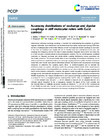Accessing distributions of exchange and dipolar couplings in stiff molecular rulers with Cu(ii) centres
dc.contributor.author
Keller, K.
dc.contributor.author
Ritsch, Irina
dc.contributor.author
Hintz, H.
dc.contributor.author
Hülsmann, M.
dc.contributor.author
Qi, M.
dc.contributor.author
Breitgoff, Frauke D.
dc.contributor.author
Klose, Daniel
dc.contributor.author
Polyhach, Yevhen
dc.contributor.author
Yulikov, Maxim
dc.contributor.author
Godt, A.
dc.contributor.author
Jeschke, Gunnar
dc.date.accessioned
2020-10-13T11:45:40Z
dc.date.available
2020-10-13T10:56:41Z
dc.date.available
2020-10-13T11:45:40Z
dc.date.issued
2020-10-14
dc.identifier.issn
1463-9084
dc.identifier.issn
1463-9076
dc.identifier.other
10.1039/d0cp03105d
en_US
dc.identifier.uri
http://hdl.handle.net/20.500.11850/445718
dc.identifier.doi
10.3929/ethz-b-000445718
dc.description.abstract
Determining distributed exchange couplings is important for understanding the properties of synthetic magnetic molecules. Such distributions can be determined from pulsed dipolar spectroscopy (PDS) data, but this is challenging due to the similar influence of both exchange and dipolar couplings on such data. In this work we introduce two models that aim to identify these two contributions to the spin–spin couplings from frequency-domain PDS data of shape-persistent molecules having either two Cu(II) ions, or a Cu(II) ion and a nitroxide radical as the paramagnetic moieties. The first model assumes correlated Lorentzian or Gaussian exchange and dipole–dipole coupling distributions whose parameters are the model's unknowns. The second model relies on prior knowledge of the distance distribution and by performing Tikhonov regularization along the exchange coupling dimension yields the latter distribution model-free. Both models were able to differentiate between the absence and the presence of exchange interaction, to determine the coupling regime (ferro- or antiferromagnetic) and to estimate the distribution shape. In contrast, calculations within the exchange resilient model of the neural network analysis implemented in DeerAnalysis2018 were not able for our data to identify exchange couplings and return correct distance distributions. However, the generic model was able to identify and separate the strongly curved intermolecular background in the relaxation-induced dipolar modulation enhancement (RIDME) experiments. Our analysis revealed that in such systems exchange coupling may be present up to at least 3.3 nm in π-conjugated systems involving Cu(II)–PyMTA, while it is negligible for distances r ≥ 4.5 nm between Cu(II) ions and r ≥ 3.8 nm between a Cu(II) ion and an unpaired electron of a nitroxide radical. Disruption of the π-conjugation between the ligand of the Cu(II) complex and the nitroxide leads to negligible exchange coupling at distances r ≥ 2.6 nm in the corresponding [Cu(II)–TAHA]–nitroxide ruler. Overall, for cases with known distance distributions, the presented analysis techniques allow to determine distributions of exchange couplings from PDS data.
en_US
dc.format
application/pdf
en_US
dc.language.iso
en
en_US
dc.publisher
Royal Society of Chemistry
en_US
dc.rights.uri
http://creativecommons.org/licenses/by-nc/3.0/
dc.title
Accessing distributions of exchange and dipolar couplings in stiff molecular rulers with Cu(ii) centres
en_US
dc.type
Journal Article
dc.rights.license
Creative Commons Attribution-NonCommercial 3.0 Unported
dc.date.published
2020-09-14
ethz.journal.title
Physical Chemistry Chemical Physics
ethz.journal.volume
22
en_US
ethz.journal.issue
38
en_US
ethz.journal.abbreviated
Phys. Chem. Chem. Phys.
ethz.pages.start
21707
en_US
ethz.pages.end
21730
en_US
ethz.version.deposit
publishedVersion
en_US
ethz.grant
Generation of spin-label based restraints on biomolecular structure and their use in hybrid structure modelling
en_US
ethz.identifier.wos
ethz.identifier.scopus
ethz.publication.place
Cambridge
en_US
ethz.publication.status
published
en_US
ethz.leitzahl
ETH Zürich::00002 - ETH Zürich::00012 - Lehre und Forschung::00007 - Departemente::02020 - Dep. Chemie und Angewandte Biowiss. / Dep. of Chemistry and Applied Biosc.::02543 - Inst. f. Molekulare Physikalische Wiss. / Institute of Molecular Physical Science::03810 - Jeschke, Gunnar / Jeschke, Gunnar
en_US
ethz.leitzahl.certified
ETH Zürich::00002 - ETH Zürich::00012 - Lehre und Forschung::00007 - Departemente::02020 - Dep. Chemie und Angewandte Biowiss. / Dep. of Chemistry and Applied Biosc.::02543 - Inst. f. Molekulare Physikalische Wiss. / Institute of Molecular Physical Science::03810 - Jeschke, Gunnar / Jeschke, Gunnar
en_US
ethz.grant.agreementno
169057
ethz.grant.fundername
SNF
ethz.grant.funderDoi
10.13039/501100001711
ethz.grant.program
Projekte MINT
ethz.date.deposited
2020-10-13T10:56:51Z
ethz.source
FORM
ethz.eth
yes
en_US
ethz.availability
Open access
en_US
ethz.rosetta.installDate
2020-10-13T11:45:57Z
ethz.rosetta.lastUpdated
2024-02-02T12:18:21Z
ethz.rosetta.versionExported
true
ethz.COinS
ctx_ver=Z39.88-2004&rft_val_fmt=info:ofi/fmt:kev:mtx:journal&rft.atitle=Accessing%20distributions%20of%20exchange%20and%20dipolar%20couplings%20in%20stiff%20molecular%20rulers%20with%20Cu(ii)%20centres&rft.jtitle=Physical%20Chemistry%20Chemical%20Physics&rft.date=2020-10-14&rft.volume=22&rft.issue=38&rft.spage=21707&rft.epage=21730&rft.issn=1463-9084&1463-9076&rft.au=Keller,%20K.&Ritsch,%20Irina&Hintz,%20H.&H%C3%BClsmann,%20M.&Qi,%20M.&rft.genre=article&rft_id=info:doi/10.1039/d0cp03105d&
Dateien zu diesem Eintrag
Publikationstyp
-
Journal Article [128837]

